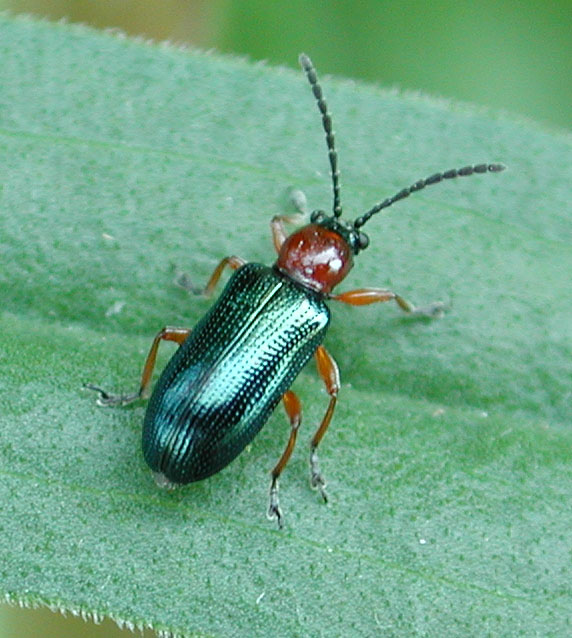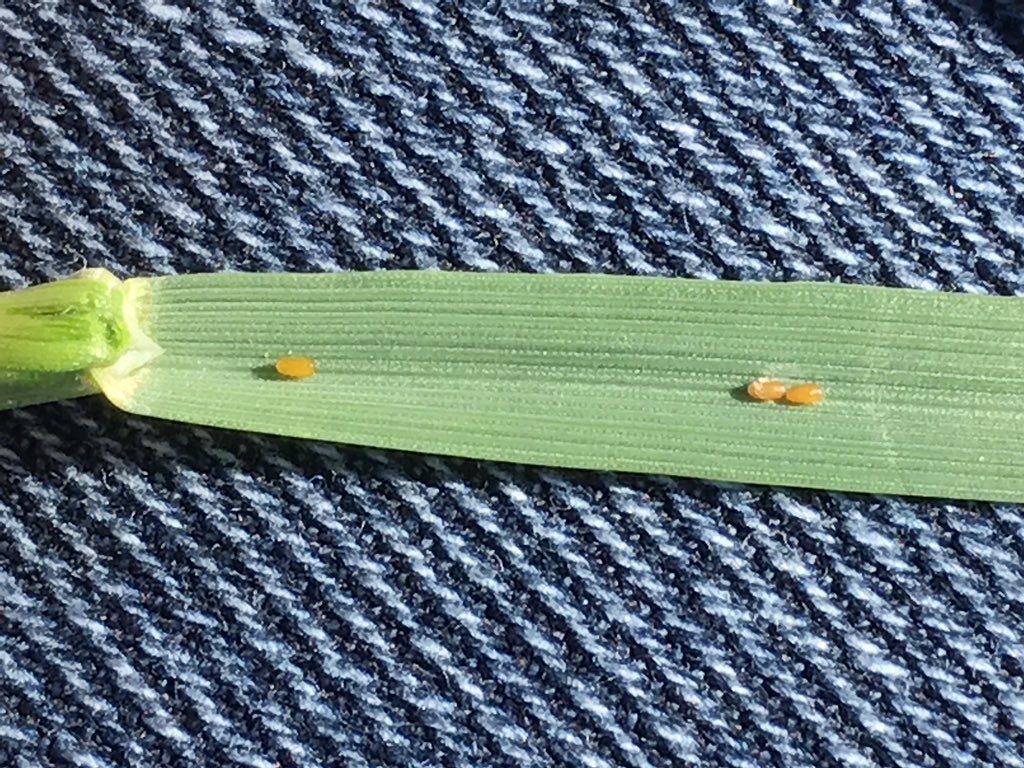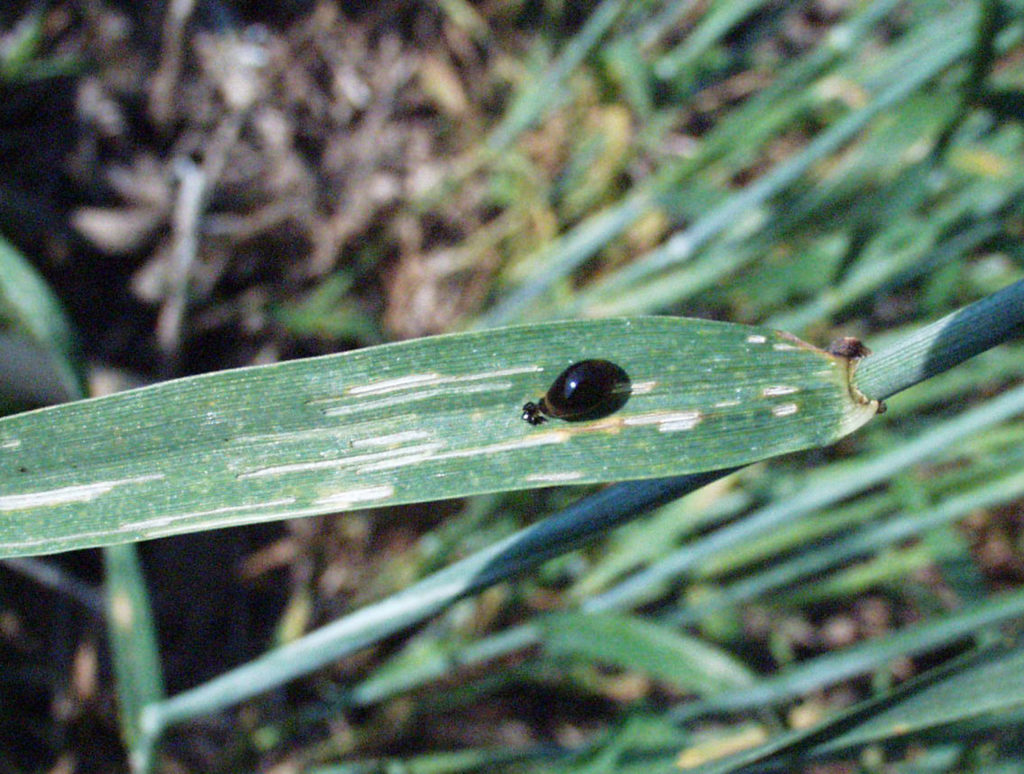Identification
Cereal leaf beetle (CLB) adults have metallic, blue-green wings, are approximately 5 mm (1/5 in.) in length, with a reddish-orange head and legs (figure 1).

CLB eggs are football shaped and approximately 0.5 mm in length (figure 2). They are laid on the upper surface of the leaf, close to the midrib and start out as bright yellow in colour, changing to orangish-brown a they mature.

The larvae are 6 mm (1/4 in.) in length when mature and yellowish in colour, but this colour is hidden by a black deposit of their fecal material making it slug-like in appearance (figure 3). This creates a dome around them, keeping them moist in dry conditions while protecting them from predators. When this outer coating is removed, you will find a yellowish beige larva underneath with a brown head and three pairs of small brown legs at the front of the body.

Biology
Cereal leaf beetles have several host crops including wheat, oats, rye, triticale, timothy, corn, barley and some grassy weeds but thrive most on wheat, oats and barley.
Cereal leaf beetles overwinter as adults in leaf litter in sheltered areas such as woodlots and heavy crop debris. These adults emerge in early spring. Mated females lay their eggs on the upper surface of leaves.
The eggs hatch, and larvae are present by late-May. The larvae feed for approximately 10 to 14 days, going through four instars before pupating in the soil, close to the base of the plants. Larvae are the most damaging stage of the pest.
Adults emerge by mid-June. Adults feed on wheat briefly and then congregate in corn fields, feeding for a short period before going into diapause until fall. In the fall, adults become active again, feed briefly on available host plants and make their way to their over-wintering sites. There is one generation per year.
Both larvae and adults feed on the leaf surface, chewing long scratches that run parallel with the leaf veins (figure 4). Leaves become skeletonized or window-paned. Heavy infestations cause the field to look silver and similar to frost damage from a distance (figure 5).


Period of Activity
Late April to end of June. Peak feeding typically occurs mid-May to early June.
Scouting Notes
Spring plantings are most attractive, particularly late plantings, though some winter wheat can also be infested in the spring. A few locations tend to experience a higher frequency of infestations including fields near Dresden, Bolton, Stayner, Seaforth, and Clinton.
Begin scouting in late April. Examine 20 plants in five locations across the field. It is important to scout various areas of the field, as CLB tends to be unevenly distributed across the field. Record the number of beetles and larvae found per plant. Scout every 5 days, as damage can increase dramatically within days.
A good indication that you have CLB in your field is if you find black streaks across your pant legs after walking through the field.
Thresholds
If an average of three larvae per tiller are found before boot stage, spray is warranted. One CLB adult or larvae per stem warrants control after boot but prior to heading. If significant feeding is taking place on the flag leaf in the early heading stages, control may be warranted. Only use foliar insecticides when thresholds have been reached and pay close attention to pre-harvest intervals.
Management Notes
Preventative or Cultural Options
- No resistant cultivars are available in Canada, though some studies show that highly pubescent varieties can deter feeding. Research is underway in Ontario to screen for resistant lines.
- Clean plowing increases the risk of this pest, as it damages the overwintering sites of cereal leaf beetle parasitoids.
- Some research has found that CLB infestations were lower in fields near shelterbelts, hedgerows and wildflower strips as these provide shelter and nectar to natural enemies that can reduce pest populations.
Chemical Control Options
- Chemical control is only recommended if cereal leaf beetle population exceeds the action threshold. Unnecessary use of insecticides can harm natural enemies that help to control all cereal pests.
- Do not apply insecticides if the larvae are already larger than 2.5 cm in length.
Biological Control Options
- Tetrastichus julis is a tiny wasp that parasitizes CLB larvae and is considered the most important natural enemy for cereal leaf beetle. It spread into Ontario in the early 1970s from Michigan where it was released to control CLB, but recent surveys have found the T. julis populations have crashed in southern Ontario. Two other parasitoid wasps was found at very low levels and may be playing a role in controlling cereal leaf beetle.
- Some generalist predators like carabid beetles and spiders may play a role in managing pupal and diapausing adults in the soil.